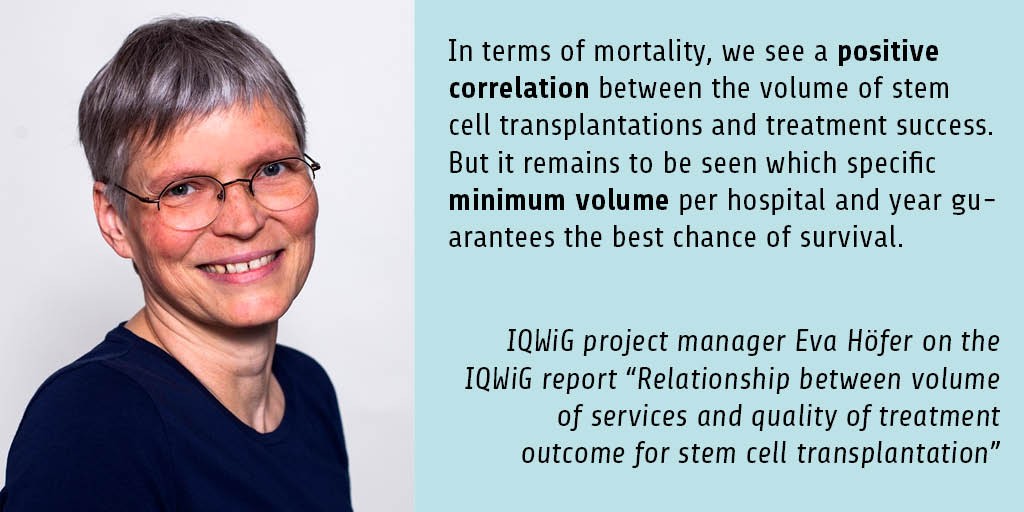Jul 2, 2019
Stem cell transplantation: chance of survival increases with number of procedures
IQWiG examines evidence for minimum volumes / G-BA commissions reports on several indications
Does the treatment success of a certain procedure depend on the number of cases in a hospital or on how often the doctors working there have already performed this procedure? In Germany, this is the subject of 8 commissions on minimum volumes awarded by the Federal Joint Committee (G-BA) to the Institute for Quality and Efficiency in Health Care (IQWiG). The IQWiG report is now available for the first indication investigated, stem cell transplantation. According to the findings, studies based on registry data show that there is indeed a correlation between treatment results and the frequency of the service provided (stem cell transplantation). This applies in particular to the survival chances of patients: The more frequently the transplantation team performs the procedure, the higher the chances of survival. In contrast, no studies could be found investigating the healthcare consequences of setting a specific minimum number of cases (25 in Germany).
Minimum Volume Regulation reformed in 2017
For about 40 years, experts have been discussing whether treatment results are better if a medical procedure is performed more frequently. In 2003, the G-BA set minimum volumes for certain plannable inpatient services for the first time: Since then, hospitals may only provide and invoice these services if they reach the set annual minimum volumes.
Since 2016, for setting minimum volumes only evidence is required “indicating a probable correlation". In 2017, the G-BA adjusted its Minimum Volume Regulation accordingly and has now commissioned IQWiG to examine the evidence in 8 indications.
Data from registries analysed
In accordance with the G-BA's commission, IQWiG searched for studies that would either allow robust conclusions to be drawn as to how the volume and quality of services provided for (autologous or allogeneic) stem cell transplantation were related, or could answer the question as to how a binding number of cases per hospital and year affected treatment success.
For the first question, IQWiG was able to include 4 observational studies (cohort studies) in the assessment, each of which had analysed patient data from international clinical registries on stem cell transplantation for malignant haematological diseases. No evidence was available for the second question, which therefore currently remains unanswered.
Only one study was highly informative
The number of patients included in the 4 studies ranged from 684 to 107,904. However, precisely the 2 largest studies were poorly informative, partly because it was unclear according to which criteria patient data had been considered in the analysis. The most informative study analysed data from 4285 patients with acute or chronic leukaemia (Loberiza 2005).
It was not possible to statistically pool the data of all studies, partly because the characteristics of the participants (e.g. age, sex, underlying disease) were too different or unknown.
Patients survived longer with a higher volume of services
Regarding mortality, the high-quality Loberiza study showed that patients survived longer after stem cell transplantation if doctors had already performed this procedure more frequently. Two studies also supported this result in terms of the volume of services provided by the hospital. However, from a methodological point of view, both of these studies were less informative.
For other outcomes, the correlations in these overall poorly informative studies were considerably weaker or even non-existent. No data at all in the 4 studies considered were available on rejection reactions in the event of a foreign donor (allogeneic stem cell transplantation) or quality of life.
It remains to be seen whether the choice of minimum volume in Germany is correct
IQWiG project manager Eva Höfer explains the results of the report: “In terms of mortality, we see a positive correlation between the volume of stem cell transplantations and treatment success. However, due to a lack of usable data, it is not possible to assess the effects of setting specific minimum volumes, for example, on patient mortality after stem cell transplantation. It therefore remains to be seen whether a case number of 25 cases per hospital location and year guarantees an optimal chance of survival for patients.”
Process of report production
In July 2018, the Federal Joint Committee (G-BA) commissioned IQWiG to prepare the report in an accelerated procedure as a so-called rapid report. Interim products were therefore not published or made available for a hearing. This rapid report was sent to the contracting agency, the G-BA, in June 2019.



